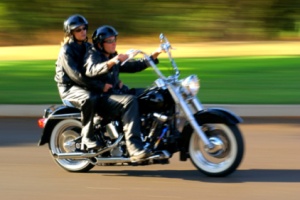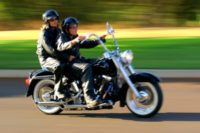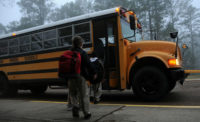 With motorcycle-related deaths on the rise – in contrast to automobile fatalities – the National Highway Traffic Safety Administration (NHTSA) is reminding drivers of cars, trucks and buses to watch out for motorcycle riders.
With motorcycle-related deaths on the rise – in contrast to automobile fatalities – the National Highway Traffic Safety Administration (NHTSA) is reminding drivers of cars, trucks and buses to watch out for motorcycle riders.
The warning is well-timed; May is Motorcycle Safety Awareness Month.
The NHTSA says motorcycle deaths have increased every year for the past 14 years except in 2009 when there was a 16 percent decline.
The numbers
In 2011, 4,612 motorcyclists died on America's roads, a 2 percent increase over those killed in 2010. In 2011, motorcycle deaths comprised 14 percent of total highway deaths, despite motorcycle registrations representing only about 3 percent of all vehicles in the country.
On a per vehicle mile basis, motorcyclists are more than 30 times more likely to die in a crash than occupants of cars, and five times more likely to be injured.
"Motorists and motorcyclists have a common responsibility to safely share the road together," said U.S. Transportation Secretary Ray LaHood.
Head injury is the leading cause of death in motorcycle crashes. Helmets are estimated to be 37 percent effective in preventing fatal injuries to motorcycle riders. NHTSA estimates that helmets saved the lives of more than 1,600 motorcyclists in 2011. If all motorcyclists had worn helmets, an additional 703 lives could have been saved. In 2011, 20 States, the District of Columbia, and Puerto Rico required helmet use by all motorcyclists.
Alcohol continues to be a factor in motorcycle fatalities. In 2011, 42 percent of motorcycle riders who died in single-vehicle crashes had blood alcohol concentration (BAC) levels of .08 or higher, higher than any other type of driver. The problem is especially acute at night. Motorcycle riders killed in traffic crashes at night were more than 3 times more likely to have BAC levels of .08 or higher than those killed during the day.
To prevent motorcyclist's deaths and injuries, NHTSA offers the following safety recommendations:
For motorcyclists:
- Never ride impaired or distracted.
- Obey traffic laws, wear DOT-compliant helmets and other protective gear.
- Make yourself visible by wearing bright colors and using reflective tape.
- Avoid riding in poor weather conditions.
- Use turn signals for every turn or lane change, even if you think no one will see it.
- Combine hand signals and turn signals to draw more attention to yourself.
- Position yourself in the lane where you will be most visible to other drivers.
For drivers:
- Never drive distracted. Doing so can result in tragic consequences for motorcyclists.
- Allow a motorcyclist a full lane width. Although it may seem that there is enough room in the traffic lane for a motor vehicle and a motorcycle, the motorcycle needs the room to maneuver safely. Do not share the lane.
- Always signal your intentions before changing lanes or merging with traffic. This allows motorcyclists to anticipate traffic flow and find a safe lane position.
- Because of its smaller size, a motorcyclist can be hidden in a vehicle's blind spot. Always check for motorcycles by checking mirrors and blind spots before entering or leaving a lane of traffic and at intersections.
- Turn signals on motorcycles are not the same as those on motor vehicles – motorcycle signals are usually not self-canceling and riders sometimes forget to turn them off. Allow enough time to determine the motorcyclist's intention before you proceed.
- Remember that road conditions that are minor annoyances to motorists can pose major hazards to motorcyclists. Motorcycle riders may change speed or adjust position within a lane suddenly in reaction to road and traffic conditions such as potholes, gravel, wet or slippery surfaces, pavement seams, railroad crossings, and grooved pavement.
- Allow more following distance, three or four seconds, when following a motorcycle so the motorcycle rider has enough time to maneuver or stop in an emergency. In dry conditions, motorcycles can stop more quickly than cars.
Motorcycle Safety Awareness Month is a national initiative designed to encourage drivers of all other kinds of vehicles and motorcyclists to "share the road" with each other. For more information, visit www.nhtsa.gov/Safety/Motorcycles.



